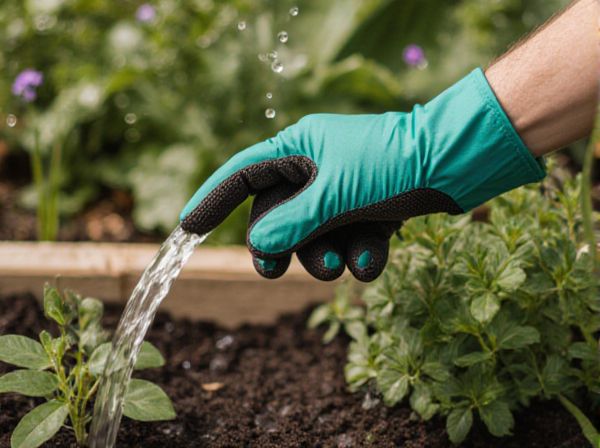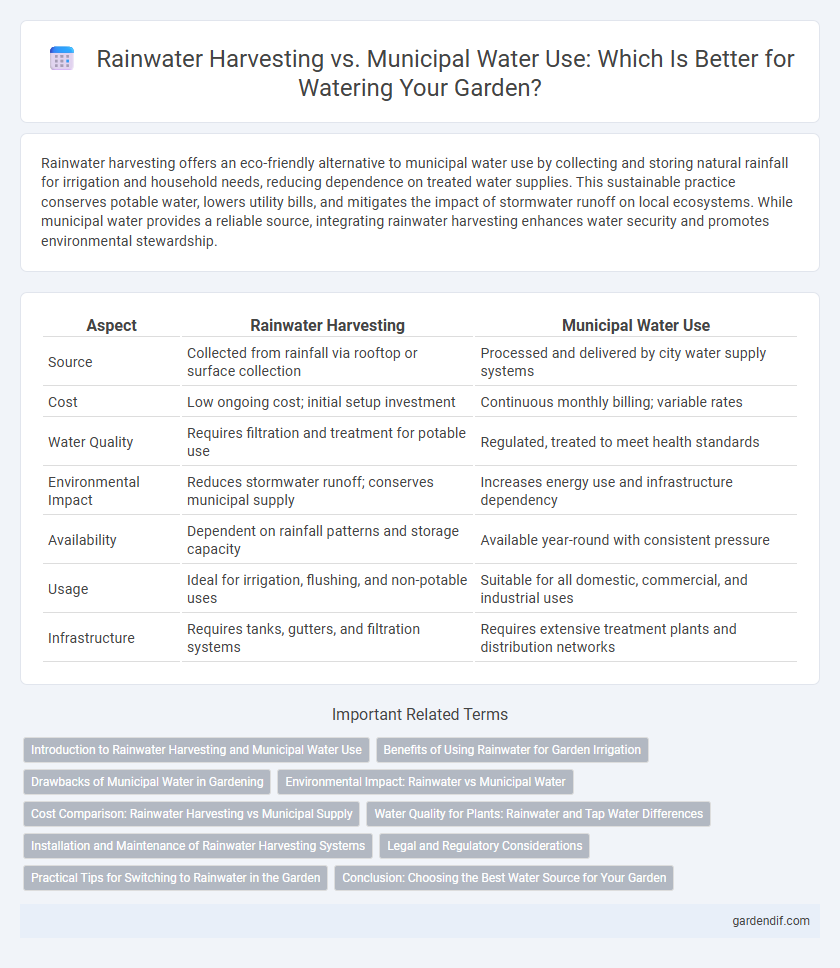
Rainwater harvesting vs Municipal water use Illustration
Rainwater harvesting offers an eco-friendly alternative to municipal water use by collecting and storing natural rainfall for irrigation and household needs, reducing dependence on treated water supplies. This sustainable practice conserves potable water, lowers utility bills, and mitigates the impact of stormwater runoff on local ecosystems. While municipal water provides a reliable source, integrating rainwater harvesting enhances water security and promotes environmental stewardship.
Table of Comparison
| Aspect | Rainwater Harvesting | Municipal Water Use |
|---|---|---|
| Source | Collected from rainfall via rooftop or surface collection | Processed and delivered by city water supply systems |
| Cost | Low ongoing cost; initial setup investment | Continuous monthly billing; variable rates |
| Water Quality | Requires filtration and treatment for potable use | Regulated, treated to meet health standards |
| Environmental Impact | Reduces stormwater runoff; conserves municipal supply | Increases energy use and infrastructure dependency |
| Availability | Dependent on rainfall patterns and storage capacity | Available year-round with consistent pressure |
| Usage | Ideal for irrigation, flushing, and non-potable uses | Suitable for all domestic, commercial, and industrial uses |
| Infrastructure | Requires tanks, gutters, and filtration systems | Requires extensive treatment plants and distribution networks |
Introduction to Rainwater Harvesting and Municipal Water Use
Rainwater harvesting captures and stores precipitation for irrigation, reducing reliance on municipal water supplies and promoting sustainable water management. Municipal water use depends on centralized treatment plants and infrastructure to distribute potable water, often involving higher energy consumption and costs. Integrating rainwater harvesting in watering practices decreases pressure on municipal systems and enhances water conservation efforts.
Benefits of Using Rainwater for Garden Irrigation
Rainwater harvesting for garden irrigation reduces dependence on municipal water supplies, conserving valuable treated water and lowering utility bills. It provides plants with naturally soft water free from chemicals and salts commonly found in tap water, promoting healthier growth and soil quality. Utilizing rainwater also minimizes stormwater runoff, decreasing erosion and nutrient pollution in local waterways.
Drawbacks of Municipal Water in Gardening
Municipal water use in gardening often leads to higher costs due to treatment and delivery expenses, while over-reliance on this source can strain local water supplies during droughts. Chlorine and other chemicals in municipal water can harm sensitive plants and soil microorganisms, reducing garden health and biodiversity. In contrast, rainwater harvesting offers a sustainable alternative by providing natural, chemical-free water that supports robust plant growth and conserves municipal resources.
Environmental Impact: Rainwater vs Municipal Water
Rainwater harvesting significantly reduces dependence on municipal water, lowering the environmental footprint by minimizing energy consumption associated with water treatment and distribution. Capturing rainwater helps decrease stormwater runoff, reducing soil erosion and water pollution in urban ecosystems. Municipal water systems often rely on extensive infrastructure that consumes large amounts of fossil fuels and contributes to greenhouse gas emissions, making rainwater harvesting a more sustainable option for maintaining environmental balance.
Cost Comparison: Rainwater Harvesting vs Municipal Supply
Rainwater harvesting systems often have higher initial setup costs due to the need for collection surfaces, storage tanks, and filtration units, but they drastically reduce long-term expenses by minimizing dependence on municipal water and lowering utility bills. Municipal water use incurs continuous monthly fees and potential rate increases, leading to higher lifetime costs compared to rainwater harvesting. Over time, rainwater harvesting proves cost-effective, especially in regions with frequent rainfall and rising municipal water prices.
Water Quality for Plants: Rainwater and Tap Water Differences
Rainwater harvesting provides plants with naturally soft water free from chlorine, fluoride, and salts, enhancing nutrient absorption and reducing soil toxicity. Municipal tap water often contains treatment chemicals and higher mineral content, which can alter soil pH and impede plant growth over time. Utilizing rainwater improves plant health by maintaining optimal water quality tailored for sustainable gardening and landscaping.
Installation and Maintenance of Rainwater Harvesting Systems
Rainwater harvesting systems require initial installation of gutters, storage tanks, and filtration units, which can range from simple barrels to advanced underground reservoirs depending on the scale. Maintenance involves regular cleaning of gutters, filters, and tanks to prevent clogging and contamination, ensuring water quality and system efficiency. Compared to municipal water, rainwater harvesting reduces dependency on centralized supply but demands consistent upkeep for sustainable use in gardening and irrigation.
Legal and Regulatory Considerations
Rainwater harvesting is subject to varied legal frameworks, often requiring permits or adherence to specific local regulations that govern water rights and system installation standards. In contrast, municipal water use is regulated under established public utility laws ensuring consistent delivery, quality standards, and consumer protections. Compliance with these legal and regulatory considerations is essential to avoid penalties and optimize water resource management.
Practical Tips for Switching to Rainwater in the Garden
Switching to rainwater harvesting for garden irrigation drastically reduces dependency on municipal water, conserving resources and lowering utility bills. Practical tips include installing rain barrels or tanks with proper filtration, positioning collection systems to optimize runoff capture, and using drip irrigation to maximize water efficiency. Regular maintenance of storage containers and monitoring water levels ensure a reliable and sustainable supply for your garden.
Conclusion: Choosing the Best Water Source for Your Garden
Rainwater harvesting offers a sustainable, cost-effective alternative to municipal water, reducing dependence on treated supplies and lowering environmental impact. Municipal water provides consistent availability and quality control, ensuring reliable irrigation during dry periods or low rainfall. Selecting the best water source depends on climate conditions, garden size, and resource accessibility, with many gardeners opting for a hybrid approach to maximize efficiency and sustainability.
Rainwater harvesting vs Municipal water use Infographic

 gardendif.com
gardendif.com